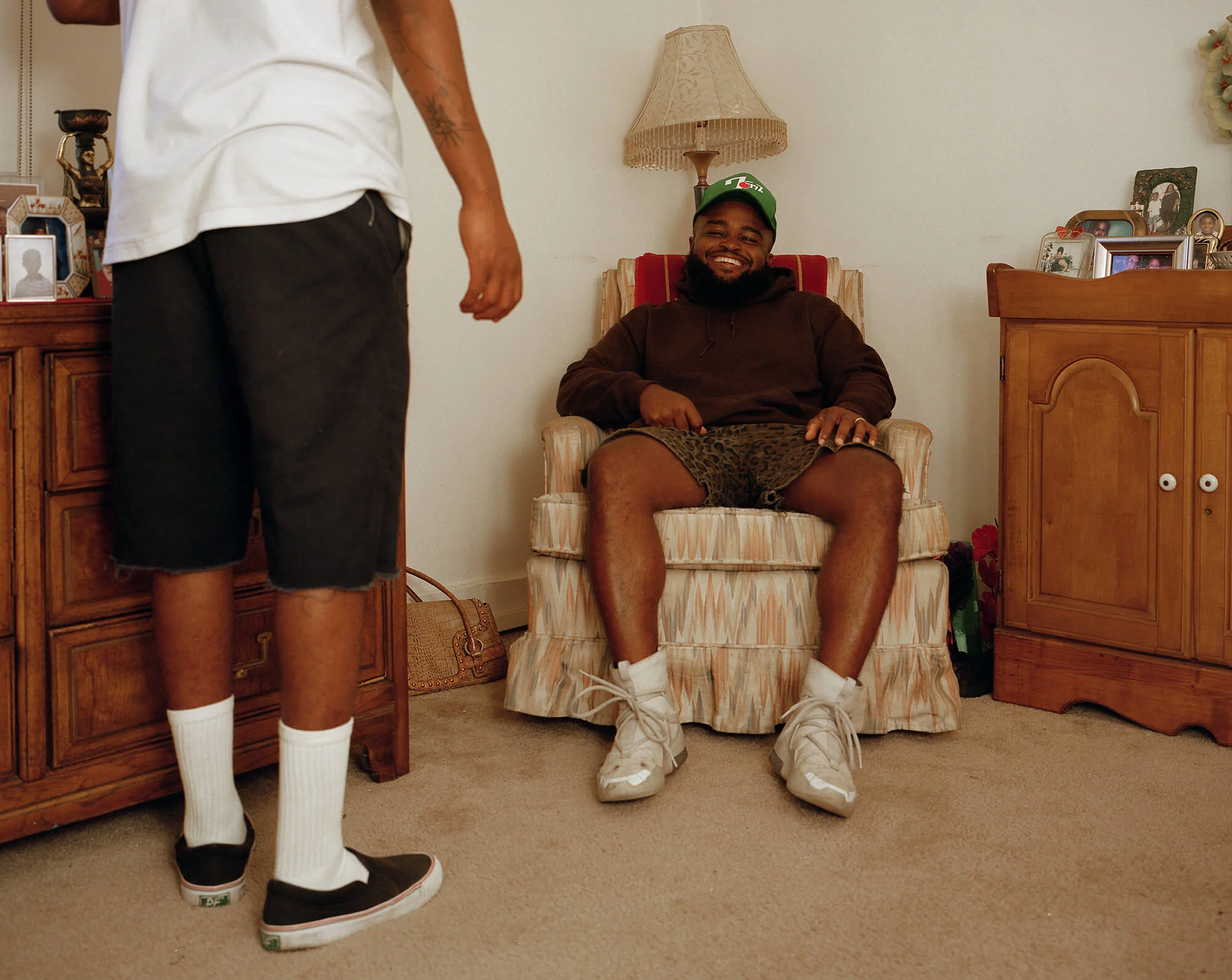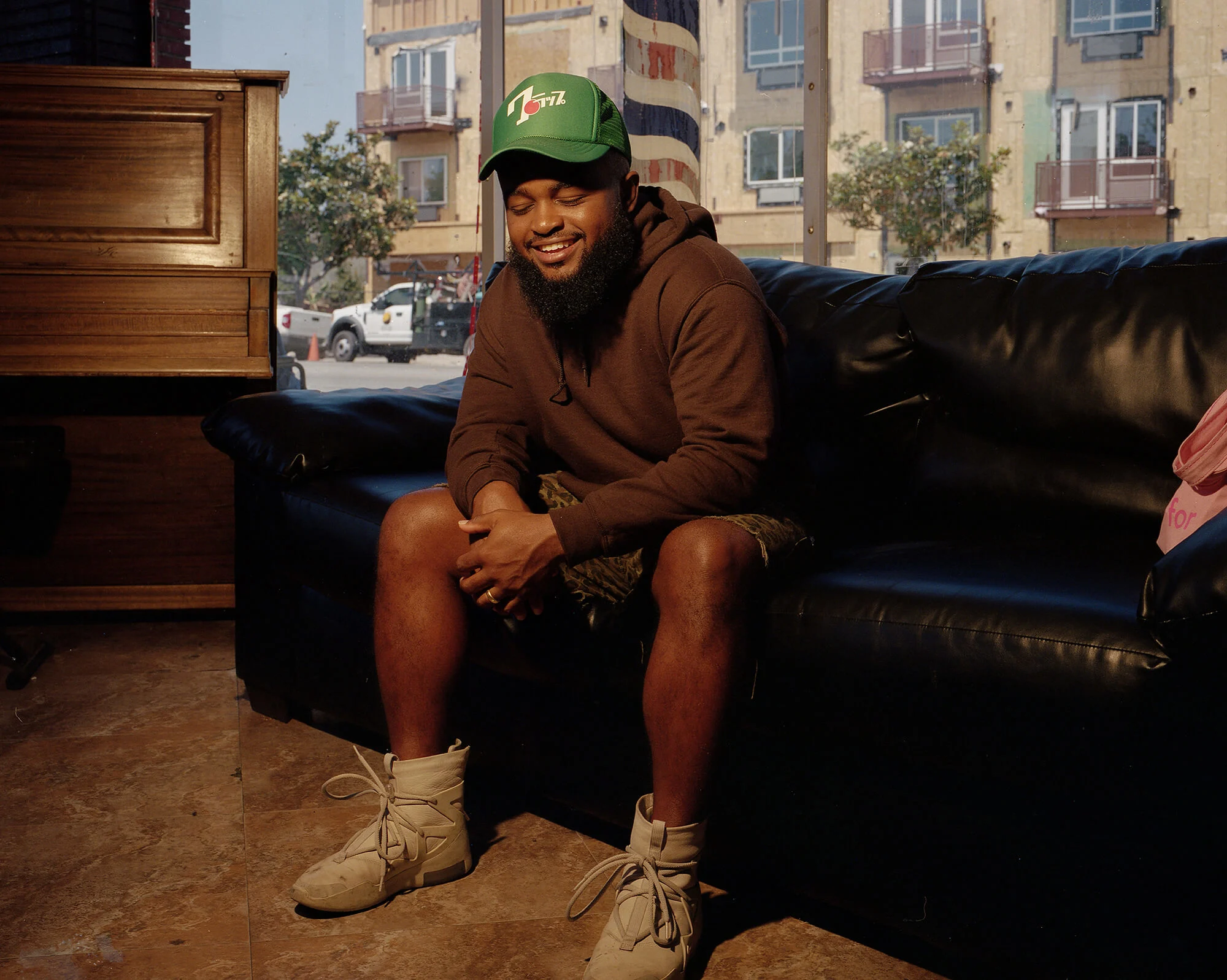

Steadily working his way up the music video ladder over the past ten years, Los Angeles-based director Calmatic has produced standout work for the likes of Anderson .Paak and Tyler, The Creator. Then came the video that may well define a decade. Here the visionary tells Andy Hermann how it happened.
Photos by Nico Young.
The first time video director Calmatic heard Old Town Road, he had the same reaction nearly everyone did. “I literally responded — is this a joke?”
But Columbia Records, the label that had sent him the track, wasn’t kidding around. They had just signed Lil Nas X, the 20-year-old Atlanta rapper behind the offbeat country/hip-hop hybrid. At the time, the song’s only video was a bunch of clips Lil Nas edited together from Red Dead Redemption 2, a Wild West video game. Clearly, with Old Town Road rapidly climbing the charts, something more official was needed.
Columbia chose wisely when they hired Calmatic. Over a prolific career spanning less than a decade, the Los Angeles director has shot witty, eye-popping clips for the likes of Anderson .Paak, Vince Staples, Lizzo, Zayn Malik, The Internet and Tyler, the Creator. Along the way, he’s developed an instantly recognizable visual vocabulary, one that combines his hyper-kinetic camera work and editing style with the whimsy of Spike Jonze (one of his heroes) and the lushness of Paul Hunter (another hero, also a mentor since Calmatic signed to Hunter’s Prettybird creative agency in 2017).
Born and raised in South Central Los Angeles, Calmatic grew up steeped in hip-hop culture. Originally he wanted to produce beats. But his skill set eventually led him down another path.
“I was a computer nerd. That kinda became my reputation,” he says, kicking back in the small, cluttered office space he keeps in L.A.’s Highland Park neighborhood. An old Super 8 camera rests on a corner table; Mekhi Phifer and Cam’ron glare down from a framed Paid in Full poster hanging over his desk. The director still lives in South Central, but rented out this office a few years ago to be closer to the action; the rapidly gentrifying Highland Park has become a hub for L.A. creatives. Celebrated hip-hop label Stones Throw is just down the block; Black Dynamite and Luke Cage soundtrack composer Adrian Younge owns the combination record shop and hair salon next door.
Calmatic credits his technical proficiency to the Al Wooten Jr. Heritage Center in South Central, which hosted after-school and summer programs that kept him off the streets and gave him his first taste of surfing the web — still a novel experience for a 10-year-old in the mid-‘90s. “There was a computer lab that had AOL on it,” he says. “I remember going to Dodgers.com and Oprah.com ‘cause those were the only websites I knew.”


After high school, he built websites and MySpace pages for local bands and rappers as often as he made beats. To Cal, they were two sides of the same coin. “I was always into how things worked — how computers worked, how music worked.” He also devoured any behind-the-scenes content or bonus features that revealed how his favorite films, videos and music got made. “I became obsessed with the process.”
After his home was robbed in 2010, Cal used the renters insurance money to get a Canon 7D digital camera. He’d already been experimenting with still photography — but now, “instead of taking pictures of my friends in the studio, I’m filming them. So it’s like, let’s shoot a video.”
Most of his earliest forays into video were with Overdoz, a hip-hop quartet from South Central’s Crenshaw District with whom he’s still closely affiliated. “It just so happened that they had a really cool look and really good music,” he says. “So it wasn’t really hard to make those videos stand out.”


Calmatic has directed no fewer than 10 Overdoz videos since 2010. Taken together, they trace the trajectory of his talent — from the no-budget but cleverly edited Growin’ Pains to 2017’s darker, more cinematic District. Pasadena, a clip from 2011, is a major leap forward — not just in its use of visual effects (which Cal taught himself how to use) to make Overdoz’s eyes bug out of their heads, but in its breakneck edits and sped-up camera work. Shot at night all over the streets and tunnels of downtown L.A., the video is both gritty and slapstick — J. Dilla meets Daffy Duck.
“That was a labor of love,” Cal says. “We shot that video over like four nights. We didn’t have any budget. That was just me and the camera.”

If you listen to J Dilla, if you listen to weird-ass MF Doom underground hip-hop — I’m editing to that feeling.
To drum up business for his nascent directing career, Calmatic brought his camera to clubs and hip-hop nights all over L.A. He shot a series of guerrilla-style videos, posting up outside shows and shooting rappers freestyling on the sidewalk or in the parking lot. His timing couldn’t have been better. Los Angeles circa 2010 was teeming with future superstars he’d go on to work with, including Tyler, the Creator, Anderson .Paak and Kendrick Lamar. A recent collab with Lamar fell through, but Cal’s 2010 clip for Monster Freestyle, despite its zero-budget production values, remains one of his most riveting clips.
Cal recalls the first time he saw Paak — then still operating under the name Breezy Lovejoy — at a club in Leimert Park, the historic neighborhood that’s long been the heart of L.A. African-American culture. “There’s this dude rapping and playing the drums at the same time. I’m like, ‘That shit is tight as fuck.’”
Paak’s first Calmatic-directed video, shot for $300, was never finished. But it sparked a creative partnership that culminated in last year’s Bubblin’, widely hailed as one of the best videos of 2018. In it, Paak races through a series of surreal situations fueled by a lucky discovery — a portable ATM that spits a constant stream of cash. He buys a zebra, swan dives into a swimming pool full of Benjamins, turns a burger joint into a strip club. It’s wildly entertaining, both a send-up of and homage to those pool-parties-and-bling hip-hop videos of the late ‘90s and early 2000s. And it’s all shot and cut with a beatmaker’s sense of rhythm and pace that matches Paak’s ebullient energy frame for frame.
Cal credits his early efforts in hip-hop production with informing his rhythmic approach to filmmaking. “If you listen to J Dilla, if you listen to weird-ass MF Doom underground hip-hop — I’m editing to that feeling. There’s the weird in-between cuts and all kinda shit like that. That’s how I get down.” He’s even mastered the visual equivalent of a DJ’s drop. A signature Calmatic move is to interrupt the music for some humorous dialogue, then smash-cut back to the most energetic part of the song. In Bubblin’, that comes when the ATM takes a break from making it rain for Paak to commiserate with a girlfriend over some merlot. “Oh, no, sweetie, you can’t let him do you like that,” actress Dolly Gray says, before stuffing her bra with twenties and adding, “I like where this is going.”

When you first meet Calmatic, his good humor and positivity is infectious. The smile never leaves his face. But the longer you talk to him, the more you realize that he has a smile for every mood: mischievous, excited, rueful, contemplative.
In discussing Bubblin’, his smile tightens a little. It’s a look of frustration. Though usually humble, he’s rightfully irritated that Bubblin’ didn’t get any major award nominations. But at least it helped pave the way for Old Town Road, which offers further proof that he’s one of the wittiest and most original music video makers working today. And thanks to the song’s runaway success — as of this writing, it’s had the longest run at number one of any single since Despacito — he’s likely to finally get the wider recognition he deserves.
“This video might win , but I don’t know,” says Calmatic, who’s been educating himself about Grammy eligibility windows and studying his potential competitors in the Best Music Video category. “I know I’m at least gonna be nominated.”

Initially, Calmatic wasn’t entirely sold on Old Town Road. This was before the Billy Ray Cyrus remix, before the Wrangler and Billboard country chart controversies — and long, long before it reached number one. “To be really real, I feel like the person that I am, I should have said no.” The song felt like a novelty, a throwaway — this year’s Harlem Shake, not the song of the decade.
But after a few more spins, he came around. “I was like, I actually fuck with it. It’s a really specific meme-slash-black Twitter-slash weird, Atlanta type of vibe. Where it’s like, I don’t know what’s going on, but it’s just fun in all the right ways.”


Still, when he submitted his treatment to Columbia, Calmatic wasn’t married to the project. “I kinda wrote it in a, ‘I don’t give a fuck if this happens or doesn’t happen. This is how I see it.’” He’s still early enough in his career that this take-it-or-leave-it mentality was unfamiliar and ultimately thrilling — especially when Columbia approved the treatment with no major changes. All through the shooting process, Cal remembers thinking, “I can’t believe they’re letting me do this shit.” Since his early days with Overdoz, “I’ve never had this much control over a video.”
The results speak for themselves. Calmatic’s video captures Old Town Road’s moment from every angle. There’s a black Western starring Chris Rock and Haha Davis set in 1889 (shot on the same ranch where they filmed Westworld), a cowboy/ghetto culture clash with a horse-versus-muscle car street race (spoiler alert: the horse wins), and a bingo parlor turned hick-hop hoedown, complete with the visual non-sequitur of super-producer Diplo playing a washboard. The mashup of country and rap should no longer surprise us — as many critics have pointed out, rappers Bubba Sparxxx and Cowboy Troy were doing it nearly 20 years ago. But it’s hard not to empathize with the guy early in the video who, went confronted with the sight of Lil Nas X performing a slow two-step in full ranch-hand leathers, holds his cellphone aloft to capture the moment with a look of stunned disbelief.

Cal is proud of the video, which has been viewed over 200 million times — far more than all his other output combined. “I feel like it’s already cemented in history,” he says. “When they do ‘I Love the 2010s’ they’re gonna show my video.”
But he’s even more proud of the uncompromising mindset that enabled him to make it exactly the way he wanted. “I couldn’t imagine it any other way,” he says. That’s not to say he’s 100 percent satisfied with how the video turned out; he’s too much of a perfectionist for that. “After we shot and edited it and everything, I just felt like something about it wasn’t right. But I’m starting to get better at that and to understand that it’s never gonna be perfect. My taste level is so high that it’s hard to satisfy myself. But,” he adds with a grin, “deep down, I know that shit is tight.”

